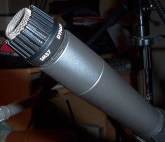Choosing the Right Microphone
Microphones have a dramatic impact on sound, so it’s important to choose wisely. Here are some things to keep in mind when making microphone decisions.
1. Condenser or Dynamic There are a couple of options to consider when choosing your microphone. The first would be whether you would like a condenser or dynamic microphone. Condenser microphones are usually highly sensitive and offer a uniform sound. They need an external source called phantom power in order for them to work, which can be provided by your mixing console, or in some cases by an internal battery. (Don’t forget to take out the battery after use!) Small diaphragm condensers are usually more accurate, while the larger diaphragm produces a fuller tone.
Dynamic microphones are typically capable of taking more abuse, whether from a loud sound source or from everyday handling. They usually have a “softer” high-end sound and produce an overall “warmer” tone. It is commonly used in micing live vocals or drums.
2. Mobility The next thing you would consider is how mobile you want your microphone to be. Do you want the mic to be permanently attached to a lectern? Then you would choose a mounted microphone. They offer great sound quality, but cannot be moved easily. Options for mics that can be moved are wired and wireless. Wired mics have a cord and offer better sound quality, but have the risk of getting tangled or limiting movement. Wireless microphones allow you to be a little more “free” to move around without an attached cord, yet you may run the risk of the signal “dropping” or receiver interference. On a good note, the quality of wireless microphones is improving everyday and these issues are not always prevalent.
3. Pattern There are several types of what is called polar patterns. The two most typical are cardiod (unidirectional) and omnidirectional. Cardiod microphones pick up sound from one side, or the front of the microphone. This is ideal in situations where you may need to control feedback. They produce clarity, but also run the risk of “drifting out of range” if you move away from it. Omnidirectional mics pick up sound equally from all sides, ideal in situations where a group of people need to be picked up with one mic.



